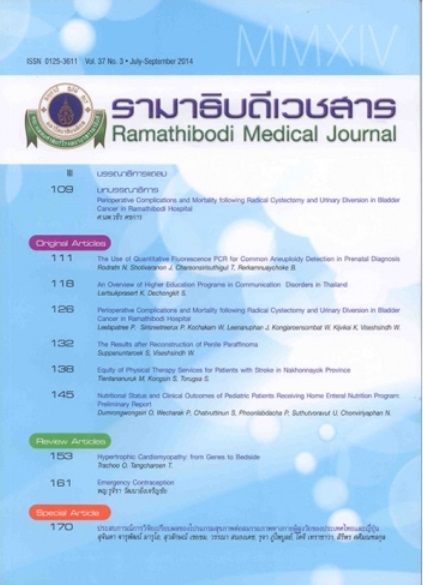Hypertrophic Cardiomyopathy: From Genes to Bedside
Keywords:
Cardiomyopathy, HCM, genetics, SUDs, surveillanceAbstract
Hypertrophic cardiomyopath (HCM) is the common hereditary cardiomyopathy found in clinical practice. The disease is defined by left ventricular hypertrophy in the absence of abnormal loading conditions. The individuals affected by HCM present with asymptomatic atatus, syncopr, congestive heart failure, arrthymia and sudden cardiac death. Common presentation often develops in teenagers and young adulthood with an autosomal dominant inheritance, with various age-dependent penetrance. Most of the genes resposible for these disorders are related to the cardiac sarcomere proteins. The diagnosis is established on cardiac imaging such as transthoracic echocardiography and/or cardiac magnatic resonance imaging. The treatment modalities include pharmacologic therapy, invasive septal reduction and implantation of pacemaker or cardiac defibrillators to prevent sudden cardiac death. Genetic counselling is highly recommended in the probands and family members sine the relatives at risk can have the benefit from longitudinal clinical surveillance to prevent further morbidity and mortality.
References
Elliott P, Andersson B, Arbustini E, et al. Classification of the cardiomyopathies: a position statement from the European Society Of Cardiology Working Group on Myocardial and Pericardial Diseases. Eur Heart J. 2008;29(2):270-276.
Elliott P. The 2006 American Heart Association classification of cardiomyopathies is not the gold standard. Circ Heart Fail. 2008;1(1):77-79. doi:10.1161/CIRCHEARTFAILURE.108.770511.
Elliott P, McKenna WJ. Hypertrophic cardiomyopathy. Lancet. 2004;363(9424):1881-1891.
Elliott P. Cardiomyopathy. Diagnosis and management of dilated cardiomyopathy. Heart. 2000;84(1):106-112.
Hada Y, Sakamoto T, Amano K, et al. Prevalence of hypertrophic cardiomyopathy in a population of adult Japanese workers as detected by echocardiographic screening. Am J Cardiol. 1987;59(1):183-184.
Codd MB, Sugrue DD, Gersh BJ, Melton LJ 3rd. Epidemiology of idiopathic dilated and hypertrophic cardiomyopathy. A population-based study in Olmsted County, Minnesota, 1975-1984. Circulation. 1989;80(3):564-572.
Maron BJ, Gardin JM, Flack JM, Gidding SS, Kurosaki TT, Bild DE. Prevalence of hypertrophic cardiomyopathy in a general population of young adults. Echocardiographic analysis of 4111 subjects in the CARDIA Study. Coronary Artery Risk Development in (Young) Adults. Circulation. 1995;92(4):785-789.
Maron BJ1, Peterson EE, Maron MS, Peterson JE. Prevalence of hypertrophic cardiomyopathy in an outpatient population referred for echocardiographic study. Am J Cardiol. 1994;73(8):577-580.
Zou Y, Song L, Wang Z, et al. Prevalence of idiopathic hypertrophic cardiomyopathy in China: a population-based echocardiographic analysis of 8080 adults. Am J Med. 2004;116(1):14-18.
Morita H, Larson MG, Barr SC, et al. Single-gene mutations and increased left ventricular wall thickness in the community: the Framingham Heart Study. Circulation. 2006;113(23):2697-2705.
Marian AJ. On genetic and phenotypic variability of hypertrophic cardiomyopathy: nature versus nurture. J Am Coll Cardiol. 2001;38(2):331-334.
Marian AJ, Roberts R. The molecular genetic basis for hypertrophic cardiomyopathy. J Mol Cell Cardiol. 2001;33(4):655-670.
Marian AJ, Salek L, Lutucuta S. Molecular genetics and pathogenesis of hypertrophic cardiomyopathy. Minerva Med. 2001;92(6):435-451.
Seidman JG, Seidman C. The genetic basis for cardiomyopathy: from mutation identification to mechanistic paradigms. Cell. 2001;104(4):557-567.
Richard P, Charron P, Carrier L, et al. Hypertrophic cardiomyopathy: distribution of disease genes, spectrum of mutations, and implications for a molecular diagnosis strategy. Circulation. 2003;107(17):2227-2232.
Schwartz ML, Cox GF, Lin AE, et al. Clinical approach to genetic cardiomyopathy in children. Circulation. 1996;94(8):2021-2038.
Nugent AW, Daubeney PE, Chondros P, et al. Clinical features and outcomes of childhood hypertrophic cardiomyopathy: results from a national population-based study. Circulation. 2005;112(9):1332-1338.
Maron MS, Olivotto I, Betocchi S, et al. Effect of left ventricular outflow tract obstruction on clinical outcome in hypertrophic cardiomyopathy. N Engl J Med. 2003;348(4):295-303.
Maron MS, Olivotto I, Zenovich AG, et al. Hypertrophic cardiomyopathy is predominantly a disease of left ventricular outflow tract obstruction. Circulation. 2006;114(21):2232-2239.
Elliott PM, Gimeno JR, Thaman R, et al. Historical trends in reported survival rates in patients with hypertrophic cardiomyopathy. Heart. 2006;92(6):785-791.
Olivotto I, Cecchi F, Casey SA, Dolara A, Traverse JH, Maron BJ. Impact of atrial fibrillation on the clinical course of hypertrophic cardiomyopathy. Circulation. 2001;104(21):2517-2524.
Olivotto I, Maron BJ, Cecchi F. Clinical significance of atrial fibrillation in hypertrophic cardiomyopathy. Curr Cardiol Rep. 2001;3(2):141-146.
Kitaoka H, Kubo T, Okawa M, Hitomi N, Furuno T, Doi YL. Left ventricular remodeling of hypertrophic cardiomyopathy: longitudinal observation in rural community. Circ J. 2006;70(12):1543-1549.
Maron BJ. Sudden death in young athletes. N Engl J Med. 2003;349(11):1064-1075.
Maron BJ. Hypertrophic cardiomyopathy: a systematic review. JAMA. 2002;287:1308-1320.
Otsuka H, Arimura T, Abe T, et al. Prevalence and distribution of sarcomeric gene mutations in Japanese patients with familial hypertrophic cardiomyopathy. Circ J. 2012;76(2):453-461.
Kubo T, Kitaoka H, Okawa M, et al. Genetic screening and double mutation in Japanese patients with hypertrophic cardiomyopathy. Circ J. 2011;75(11):2654-2659.
Ko YL, Teng MS, Tang TK, et al. Genetic heterogeneity for familial hypertrophic cardiomyopathy in Chinese: analysis of six Chinese kindreds. Chin Med J (Engl). 1998;111(5):416-421.
Choi JO, Yu CW, Chun Nah J, et al. Long-term outcome of 4 Korean families with hypertrophic cardiomyopathy caused by 4 different mutations. Clin Cardiol. 2010;33(7):430-488. doi:10.1002/clc.20795.
Ng CT, Chee TS, Ling LF, et al. Prevalence of hypertrophic cardiomyopathy on an electrocardiogram-based pre-participation screening programme in a young male South-East Asian population: results from the Singapore Armed Forces Electrocardiogram and Echocardiogram screening protocol. Europace. 2011;13(6):883-888. doi:10.1093/europace/eur051.
Gersh BJ, Maron BJ, Bonow RO, et al. 2011 ACCF/AHA guideline for the diagnosis and treatment of hypertrophic cardiomyopathy: executive summary: a report of the American College of Cardiology Foundation/American Heart Association Task Force on Practice Guidelines. Circulation. 2011;124(24):2761-2796. doi:10.1161/CIR.0b013e318223e230.
Ingles J, Sarina T, Yeates L, et al. Clinical predictors of genetic testing outcomes in hypertrophic cardiomyopathy. Genet Med. 2013;15(12):972-977. doi:10.1038/gim.2013.44.
Cirino AL, Ho C. Familial hypertrophic cardiomyopathy overview. In: Pagon RA, Bird TD, Dolan CR, Stephens K, Adam MP, eds. GeneReviews® [Internet]. Seattle (WA): University of Washington, Seattle; 1993-2012.
Maron BJ, Seidman JG, Seidman CE. Proposal for contemporary screening strategies in families with hypertrophic cardiomyopathy. J Am Coll Cardiol. 2004;44(11):2125-2132.
Downloads
Published
How to Cite
Issue
Section
License
Copyright (c) 2014 By the authors. Licensee RMJ, Faculty of Medicine Ramathibodi Hospital, Mahidol University, Bangkok, Thailand

This work is licensed under a Creative Commons Attribution-NonCommercial-NoDerivatives 4.0 International License.













